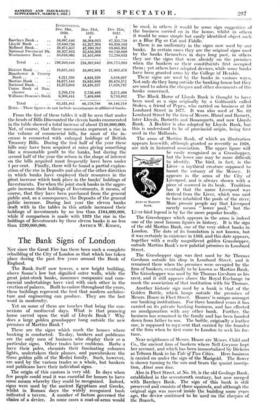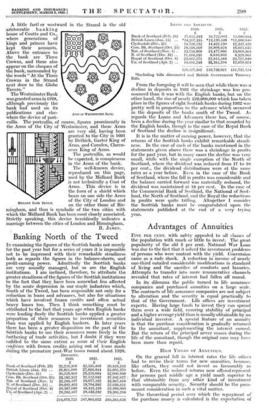The Bank Signi of London
NOT since the Great Fire has there been such a complete rebuilding of the City of London as that which has taken place during the past few years around the Bank of England.
The Bank. itself now towers, a new bright building, above Soane's low but dignified outer walls, while the great joint-stock banks, - insurance companies' and com- mercial undertakings have vied with each other in the erection of palaces. Built to endure throughout the years, these buildings represent the best that modern architec- ture and engineering can produce.. They are the last word in modernity.
Yet on some of them arc touches that bring the con- nexions of mediaeval days. What is that prancing horse carved upon the wall of Lloyds Bank ? Why dOes a large golden grasshopper hang outside the new premises of Martins Bank ?
These are the signs which mark the houses where banking is conducted. To-day, bankers and publicans are the only. men of business who display their ov n particular signs. Other trades have emblems. Barbe. s have their poles, chemists their fascinating coloured lights, undertakers their plumes, and pawnbrokers the three golden pills of the Medici family. Such, however, are used by the various trades as a whole, but bankers and publicans have their individual signs.
The origin of this custom is very old: In days when few people could read it was essential for houses to have some means whereby they could be recognized. Indeed,- signs were used by the ancient Egyptians and Greeks, whilst in Roman days the widely. recognized bush inklicated a tavern. A number of factors governed the choice of a device, In some cases a coat-of-arms would
be used, in others it would be some sign suggestive of the business carried on in the house, whilst in others it would be some simple but easily identified object such as a Blue Pig or Cat and Fiddle.
There is no uniformity in the signs now used by our banks. In certain cases they are the original signs used by the banks themselves in days bing past, in others they are the signs that were already' on the premises when the bankers or their constituents first occupied them ; yet others have adopted devices, while sonic bankyi have been granted arms by the College bf Heralds.
These signs arc used by the banks in. various ways. Not only do they hang outside the banking house but they are used to adorn the cheques and Other documents of the banks concerned.
The Black Horse of Lloyds Bank is thought to have been used as a sign originally by a Goldsmith called Stokes, a friend of Pepys, who carried on bushiest at 53 Lombard Street in 1677. It was also used at No. 62 Lombard Street by the firm of Messrs. Bland and Barnett, later Lloyds, Bametts and Bosanquets, and now Lloyds Bank. A Beehive is also adopted by Lloyds Bank, but this is understood to be of provincial origin, being first used in the Midlands.
ARMS OF MARTINS BANE.
The arms of Martins Bank, of which art illustration appears herewith, although granted so recently as 1928, are rich in historical association. The upper figure will be easily recognized as a Grasshopper, but the lower one may be more difficult to identify. The bird, in fact, is the Liver—a mythical creature supposed to haunt the estuary of the Mersey. It appears in the arms of the City of Liverpool, and is always shown with a piece of seaweed in its beak. Tradition has it that the name Liverpool was derived from the Liver, which was said to have inhabited the pools of the river; More prosaic people say that Liverpool merely means " lower pool," but the Liver-bird legend is by far the more popular locally.
The Grasshopper which appears in the arms is indeed one of the most famous figures in history. It is the sign of the old Martins Bank, one of the very oldest banks in London. The date of its foundation is not known, but it was certainly in existence in 1568, and this date appears, together with a really magnificent golden Grasshopper, outside Martins Bank's neiv palatial premises MLombard Street.
The Grasshopper sign was first used by Sir Thomas Gresham outside his shop in Lombard Street, and it remained there when the premises were occupied by the firm of bankers, eventually to be known as Martins Bank. The Grasshopper was used by Sir Thomas Gresham as his crest, and it still appears above the Royal Exchange to mark the association of that institution with Sir Thomas.
Another historic sign used by a bank is that of the Golden Bottle, which hangs outside the premises of Messrs. Hoare in Fleet Street. Hoares' is unique amongst our banking institutions. For three hundred years it has carried on its private banking business, and has effected no amalgamation with any other bank. Further, the business has remained in the family and has been handed down from father to son. The bottle, originally a leather one, is supposed to reprzsent that carried by the founder of the firm when he first came to London to seek his for- tune.
Near neighbours of Messrs. Hoare are Messrs. Child and Co., the ancient firm of bankers where Nell Gwynne kept her account, and which has been immortalized by Dickens as Telsons Bank in his Talc of Two Mies. Here business is carried on under the sign of -the Marigold. The flower is shown turning to. the sun and bears the quaint inscrip- tion, Ainsi mon &me.
Also in Fleet Street, at No. 19, is the old Goslings Bank, established in the seventeenth century, but now merged with Barclays Bank. The sign of this bank is still preserved and consists of three squirrels, and although the
original sign was_ inside the. building some years ago, the device cbtinued to 'be used' 0n the cheques of the Branchk
The Westminster Bank was granted arms in.1928, although previously the bank had used on its publications and else- where the device of port-
ARMS oP Wssrmmerra BANK.
cullis. The portcullis, of course, figures prominently in the Arms of the City of Westminster, and these Arms
MIDLAND B as DEVIcS.
on the other those of Bir-
are very old, having been granted to the City in 1601 by Dethick, Garter King of Arms, and Camden, Claren- ceux King of Arms.
The portcullis, as would be expected, is conspicuous in the Arms of the bank.
The well-known device, reproduced on this page, used by the Midland Bank )s not technically a Coat of Arms. This device is in the form of a shield which bears on one side the Arms of the City of London and mingham, and thus is symbolic of the two cities with which the Midland Bank has been most closely associated. Strictly speaking, this device heraldically indicates a marriage between the cities of London and Birmingham.
R. J 4.MES



















































 Previous page
Previous page